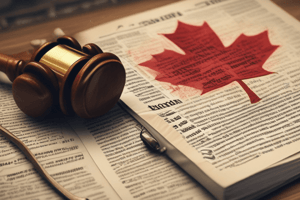Podcast
Questions and Answers
What must an off-duty officer believe in order to use force against a male inmate visitor committing an offence?
What must an off-duty officer believe in order to use force against a male inmate visitor committing an offence?
- That he is authorized to act as a peace officer at all times.
- That the visitor is a known criminal.
- That he has the support of his colleagues.
- That the amount of force used is necessary under the circumstances. (correct)
Which section of the Criminal Code provides broader protection for officers using force to disperse or arrest individuals?
Which section of the Criminal Code provides broader protection for officers using force to disperse or arrest individuals?
- CCC s. 25
- CCC s. 33 (2) (correct)
- CCC s. 32
- CCC s. 27
What is the primary limitation set on an officer causing grievous bodily harm under CCC s. 25 or s. 32?
What is the primary limitation set on an officer causing grievous bodily harm under CCC s. 25 or s. 32?
- The protection is limited for using force likely to cause serious injury. (correct)
- The officer must ask for backup before acting.
- The officer must have a visible uniform.
- The force must come from a lawful order.
After successfully defending against an unprovoked assault, when is further use of force justified?
After successfully defending against an unprovoked assault, when is further use of force justified?
Which of the following individuals can be designated as a peace officer by the Commissioner?
Which of the following individuals can be designated as a peace officer by the Commissioner?
What does the term 'escape' specifically refer to according to the legal definitions provided?
What does the term 'escape' specifically refer to according to the legal definitions provided?
What constitutes the act of permitting or assisting escape under the penal code?
What constitutes the act of permitting or assisting escape under the penal code?
Which of the following actions is classified as an indictable offence concerning escape?
Which of the following actions is classified as an indictable offence concerning escape?
What is the maximum imprisonment term for someone participating in a riot?
What is the maximum imprisonment term for someone participating in a riot?
What type of assembly is punishable by summary conviction?
What type of assembly is punishable by summary conviction?
Who is responsible for issuing a proclamation to disperse in the case of a riot?
Who is responsible for issuing a proclamation to disperse in the case of a riot?
What must individuals do after a proclamation to disperse is made?
What must individuals do after a proclamation to disperse is made?
Under what circumstances can a peace officer justify the use of force during a riot?
Under what circumstances can a peace officer justify the use of force during a riot?
What happens if a peace officer fails to act during a riot without reasonable excuse?
What happens if a peace officer fails to act during a riot without reasonable excuse?
What constitutes an indictable offense related to a proclamation?
What constitutes an indictable offense related to a proclamation?
Under what conditions can a peace officer use force intended or likely to cause death against an inmate attempting to escape from a penitentiary?
Under what conditions can a peace officer use force intended or likely to cause death against an inmate attempting to escape from a penitentiary?
What is the requirement for a person to use force to prevent the commission of an offence?
What is the requirement for a person to use force to prevent the commission of an offence?
What must be demonstrated for an act of self-defence to be considered reasonable?
What must be demonstrated for an act of self-defence to be considered reasonable?
Which of the following factors does NOT affect the assessment of reasonable force in self-defence?
Which of the following factors does NOT affect the assessment of reasonable force in self-defence?
When can a person legally arrest another without a warrant?
When can a person legally arrest another without a warrant?
What defines an unlawful assembly?
What defines an unlawful assembly?
What is the maximum term of imprisonment for a peace officer who wilfully permits a person in his lawful custody to escape?
What is the maximum term of imprisonment for a peace officer who wilfully permits a person in his lawful custody to escape?
Which group is specifically exempted from being guilty of offenses under the Act for possessing prohibited weapons during their duties?
Which group is specifically exempted from being guilty of offenses under the Act for possessing prohibited weapons during their duties?
Which of the following best defines 'public officer' as per the relevant section?
Which of the following best defines 'public officer' as per the relevant section?
What does subsection 25(1) justify regarding the use of force by officers?
What does subsection 25(1) justify regarding the use of force by officers?
Which of the following is NOT a condition for an officer to justify the use of force?
Which of the following is NOT a condition for an officer to justify the use of force?
What is the limitation defined in CCC s. 25(5) regarding the use of force?
What is the limitation defined in CCC s. 25(5) regarding the use of force?
What happens if an officer uses force beyond what is reasonably required?
What happens if an officer uses force beyond what is reasonably required?
In what scenario can an officer use lethal force under CCC s. 25(5)?
In what scenario can an officer use lethal force under CCC s. 25(5)?
What is the consequence of exceeding unauthorized limits of force according to section 26?
What is the consequence of exceeding unauthorized limits of force according to section 26?
Which of the following best describes the purpose of CCC s. 25?
Which of the following best describes the purpose of CCC s. 25?
When can an officer be excused from liability under the firearms regulation?
When can an officer be excused from liability under the firearms regulation?
What defines the penalties for a peace officer allowing a lawful escape?
What defines the penalties for a peace officer allowing a lawful escape?
What must officers demonstrate to justify the level of force used?
What must officers demonstrate to justify the level of force used?
What is one consequence if officers fail to abide by the limits set on their use of force?
What is one consequence if officers fail to abide by the limits set on their use of force?
Under what circumstances is a person justified in using force that may cause death or grievous bodily harm when executing a process or carrying out a sentence?
Under what circumstances is a person justified in using force that may cause death or grievous bodily harm when executing a process or carrying out a sentence?
Which of the following conditions must be met for a peace officer to use force intended to cause death or grievous bodily harm?
Which of the following conditions must be met for a peace officer to use force intended to cause death or grievous bodily harm?
What constitutes reasonable grounds for a peace officer to use necessary force?
What constitutes reasonable grounds for a peace officer to use necessary force?
What action must a person take when assisting a peace officer who is arresting someone?
What action must a person take when assisting a peace officer who is arresting someone?
When is a person not justified in using force intended to cause death or grievous bodily harm?
When is a person not justified in using force intended to cause death or grievous bodily harm?
For what reasons can a peace officer proceed with an arrest without a warrant?
For what reasons can a peace officer proceed with an arrest without a warrant?
What is required for someone assisting a peace officer to be justified in using force?
What is required for someone assisting a peace officer to be justified in using force?
What must be true about the flight of a person being arrested for a peace officer to justify the use of potentially lethal force?
What must be true about the flight of a person being arrested for a peace officer to justify the use of potentially lethal force?
Flashcards
Use of Force in Law Enforcement
Use of Force in Law Enforcement
A person can use force if they are required or authorized by law to do something in the administration or enforcement of the law, and they act on reasonable grounds.
Self-Preservation and Protection
Self-Preservation and Protection
This section provides justification for using force to defend oneself or others from imminent death or grievous bodily harm.
Deadly Force for Arrest
Deadly Force for Arrest
A peace officer can use deadly force to arrest someone if the officer believes it's necessary to protect themselves or others from impending or future death or serious injury, and less violent methods won't work.
Executing Legal Processes
Executing Legal Processes
Signup and view all the flashcards
Restriction on Deadly Force
Restriction on Deadly Force
Signup and view all the flashcards
Assistance to Peace Officers
Assistance to Peace Officers
Signup and view all the flashcards
Criminal Code and Force
Criminal Code and Force
Signup and view all the flashcards
Authority to Use Force
Authority to Use Force
Signup and view all the flashcards
What is 'escape' in the CCC?
What is 'escape' in the CCC?
Signup and view all the flashcards
Who is a Peace Officer in the CCC?
Who is a Peace Officer in the CCC?
Signup and view all the flashcards
How are CSC Peace Officers designated?
How are CSC Peace Officers designated?
Signup and view all the flashcards
What is 'Permitting or Assisting Escape'?
What is 'Permitting or Assisting Escape'?
Signup and view all the flashcards
What is 'Rescue or Permitting Escape'?
What is 'Rescue or Permitting Escape'?
Signup and view all the flashcards
Riot
Riot
Signup and view all the flashcards
Unlawful Assembly
Unlawful Assembly
Signup and view all the flashcards
Reading Proclamation
Reading Proclamation
Signup and view all the flashcards
Neglect by Peace Officer
Neglect by Peace Officer
Signup and view all the flashcards
Use of Force to Suppress Riot
Use of Force to Suppress Riot
Signup and view all the flashcards
Duty of Officers if Rioters Do Not Disperse
Duty of Officers if Rioters Do Not Disperse
Signup and view all the flashcards
Participating in a Riot
Participating in a Riot
Signup and view all the flashcards
Being a Member of an Unlawful Assembly
Being a Member of an Unlawful Assembly
Signup and view all the flashcards
Opposing or Hindering the Reading Proclamation
Opposing or Hindering the Reading Proclamation
Signup and view all the flashcards
Failing to Disperse after the Reading Proclamation
Failing to Disperse after the Reading Proclamation
Signup and view all the flashcards
Failing to Depart Knowing the Proclamation Would Have Been Made
Failing to Depart Knowing the Proclamation Would Have Been Made
Signup and view all the flashcards
Peace Officer
Peace Officer
Signup and view all the flashcards
Tumultuous
Tumultuous
Signup and view all the flashcards
Person Lawfully Required to Assist
Person Lawfully Required to Assist
Signup and view all the flashcards
Civil or Criminal Proceedings
Civil or Criminal Proceedings
Signup and view all the flashcards
Use of Deadly Force on Escaping Inmates
Use of Deadly Force on Escaping Inmates
Signup and view all the flashcards
Criminal Responsibility for Excessive Force
Criminal Responsibility for Excessive Force
Signup and view all the flashcards
Using Force to Prevent Offenses
Using Force to Prevent Offenses
Signup and view all the flashcards
Defense of Person - Justification for Force
Defense of Person - Justification for Force
Signup and view all the flashcards
Factors Considered in Assessing Reasonable Force
Factors Considered in Assessing Reasonable Force
Signup and view all the flashcards
Defense of Person - Limitations
Defense of Person - Limitations
Signup and view all the flashcards
Arrest Without Warrant - General Provisions
Arrest Without Warrant - General Provisions
Signup and view all the flashcards
Arrest Without Warrant - Property Owner Rights
Arrest Without Warrant - Property Owner Rights
Signup and view all the flashcards
Arrest Without Warrant - Delivering to Peace Officer
Arrest Without Warrant - Delivering to Peace Officer
Signup and view all the flashcards
Arrest Without Warrant - Peace Officer Authority
Arrest Without Warrant - Peace Officer Authority
Signup and view all the flashcards
Punishment of Rioters
Punishment of Rioters
Signup and view all the flashcards
Use of Force to Prevent an Offence
Use of Force to Prevent an Offence
Signup and view all the flashcards
Force to Suppress a Riot
Force to Suppress a Riot
Signup and view all the flashcards
Force to Enforce a Proclamation
Force to Enforce a Proclamation
Signup and view all the flashcards
Legal Protection for Enforcing a Proclamation
Legal Protection for Enforcing a Proclamation
Signup and view all the flashcards
Repelling Force with Force
Repelling Force with Force
Signup and view all the flashcards
Force in Self Defense
Force in Self Defense
Signup and view all the flashcards
Limitations on Force in Self Defense
Limitations on Force in Self Defense
Signup and view all the flashcards
Force that May Cause Death or Grievous Harm
Force that May Cause Death or Grievous Harm
Signup and view all the flashcards
Escape from Custody
Escape from Custody
Signup and view all the flashcards
Public Officer Exemption
Public Officer Exemption
Signup and view all the flashcards
Exemption for Official Duty
Exemption for Official Duty
Signup and view all the flashcards
Use of Force Justification
Use of Force Justification
Signup and view all the flashcards
Limit on Deadly Force
Limit on Deadly Force
Signup and view all the flashcards
Force to Prevent Escape
Force to Prevent Escape
Signup and view all the flashcards
Excessive Force
Excessive Force
Signup and view all the flashcards
Force to Prevent Offence
Force to Prevent Offence
Signup and view all the flashcards
Protection of Officers
Protection of Officers
Signup and view all the flashcards
Reasonable Grounds
Reasonable Grounds
Signup and view all the flashcards
General Restriction on Deadly Force
General Restriction on Deadly Force
Signup and view all the flashcards
Authorization and Reasonableness
Authorization and Reasonableness
Signup and view all the flashcards
Proportionality of Force
Proportionality of Force
Signup and view all the flashcards
Force Used in Assistance
Force Used in Assistance
Signup and view all the flashcards
Public Officer Definition
Public Officer Definition
Signup and view all the flashcards
Study Notes
Criminal Code Authority for Use of Force
- Protection of Persons Acting Under Authority (s. 25): Officers authorized by law to enforce the law (private persons, peace officers, etc.) are justified in using necessary force.
- Execution of Process/Sentences (s. 25): Executing processes or sentences is justified, even if the process is flawed or issued without jurisdiction. Assistance is also justified.
- Limitations on Force Causing Harm (s. 25): Generally, force intended to cause death or grievous bodily harm is unjustified unless the officer believes, on reasonable grounds, that it's necessary for self-preservation or to prevent harm to those under their protection.
- Peace Officer Force in Arrest (s. 25): Peace officers and their assistants are justified in using force likely to cause death or grievous bodily harm if arresting for an arrestable offense, the suspect flees, and necessary to prevent harm to themselves, assistants, or others. This is only justified if flight cannot be prevented by less violent means.
- Inmate Escape Force (s. 25): Peace officers are justified in using force likely to cause death or grievous bodily harm to prevent escapes from penitentiaries, particularly if an inmate poses an imminent threat of harm to officers or others, and if less violent means fail.
Excessive Force (s. 26)
- Criminal Responsibility: Officers are criminally responsible for using excessive force, even if otherwise authorized. The extent of responsibility depends on the nature and severity of the excess.
Use of Force to Prevent Offences (s. 27)
- Justification for Preventing Offenses: Force is justifiable if used to prevent crimes for which arrest without warrant is possible or crimes likely to cause immediate, severe harm. This includes preventing actions that would, if performed, be an offense.
Defense of Person (s. 34)
- Defense Against Force: A person is not guilty of an offense committed for the purpose of defending against or protecting themselves or another person from force or threat of force, if that defense was reasonable.
- Factors Determining Reasonableness (s. 34): Courts consider factors like the nature of the force/threat, the imminence of use of force, alternative responses, roles in the incident, use of weapons, sizes/capacities of parties, relationships, prior force, proportionality of the response, and whether the initial force was lawful.
- Exception for Lawful Enforcement (s. 34): Defense against lawful police action is not allowed, unless that action is believed, on reasonable grounds, to be unlawful.
Arrest Without Warrant (s. 494, 495)
- Arrest by Any Person (s. 494): Any person can arrest someone committing an indictable offense or who is reasonably believed to have committed a crime and is fleeing from lawful arrest authorities.
- Arrest by Property Owner (s. 494): A property owner or a person with lawful possession of property can arrest someone committing a crime on that property.
- Arrest by Peace Officer (s. 495): Peace officers may arrest someone who committed or is about to commit an indictable offense or if they reasonably believe a warrant is in effect.
Unlawful Assemblies and Riots (ss. 63-69)
- Unlawful Assembly (s. 63): Three or more people assembled with a common goal in a manner that reasonably suggests a tumultuous disturbance or provocation of others.
- Protected Assemblies (s. 63): Assembling to protect a home from break-ins is not an unlawful assembly.
- Riot (s. 64): An unlawful assembly that has started to cause a tumultuous disturbance.
- Riot Punishment (s. 65): Participating in a riot is criminally punishable.
- Unlawful Assembly Punishment (s. 66): Being a member of an unlawful assembly is a summary offense.
- Reading the Proclamation (s. 67): Certain officers are required to read a proclamation demanding dispersal to those in an unlawful assembly or riot.
- Offences Related to Proclamation (s. 68): Opposition or assault of a proclamator or failure to disperse within 30 minutes after the proclamation are punishable offenses.
- Peace Officer Neglect (s. 69): Peace officers who fail to suppress a riot without reasonable excuse are criminally punishable.
Suppressing Riots (s. 32)
- Justification for Force (s. 32): Peace officers can use the force they reasonably believe is necessary and not excessive to suppress a riot. Military and civilians under military law are also justified in taking these actions if justified under the guidelines previously stated.
- Duty of Officer When Rioters Don't Disperse (s. 33): Peace officers are obligated to disperse or arrest rioters who do not comply with the proclamation.
Additional Definitions and Considerations
- Peace Officer Status (CCC par. 2, CCRA s. 10, definitions): Descriptions of who is considered a peace officer.
- Escape Definitions (CCC s. 149): Clarification of what constitutes escaping from custody.
- Permitting or Assisting Escape (CCC s. 146): Specific actions and obligations regarding preventing escape from custody.
- Rescue or Permitting Escape (CCC s. 147): Criminally punishable to permit the escape of someone in custody.
- Exempt Persons (CCC s. 117.07): Clarification on when certain individuals dealing with prohibited items or materials are exempt from criminal charges related to these actions.
Studying That Suits You
Use AI to generate personalized quizzes and flashcards to suit your learning preferences.




